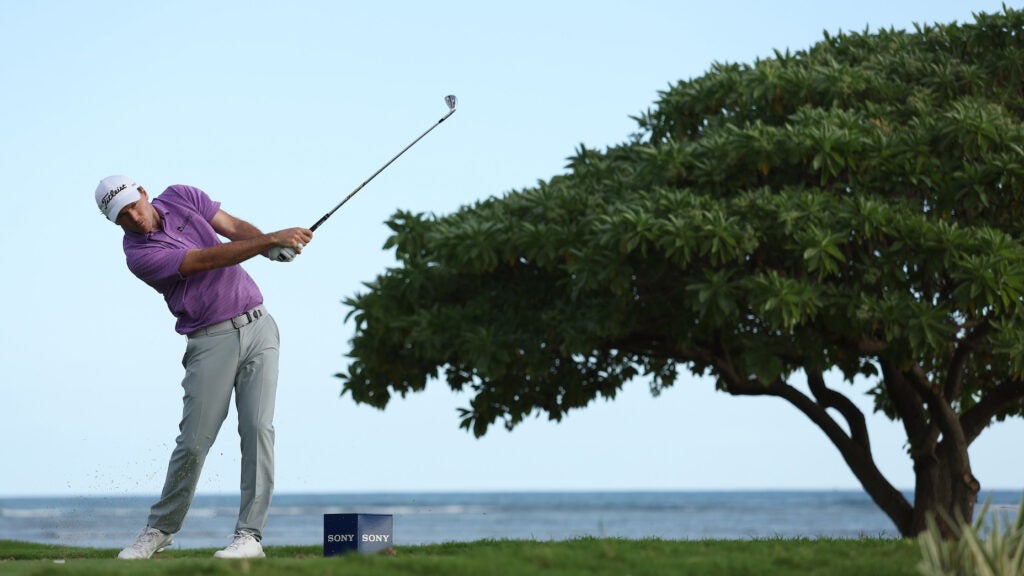Russell Henley seems to be solving one of the most elusive problems in golf: he’s figured out how to recapture his best form.
It was less than two years ago that Henley, a multiple-time PGA Tour winner, had tumbled down to 251st in the Official World Golf Ranking. For many golfers, it’s hard to climb back up. But Henley scrapped his way back: A third at last year’s Honda Classic, followed by a combination of top 10s, 15s and 20s (including a T13 at the 2021 U.S Open, where he at times held the lead) means he’s now back inside the top 50.
A win in Hawaii would’ve been a nice way to cap it off, but Hideki Matsuyama — and his 3-wood — was too good down the stretch. But Russell’s deserved trophy is surely just around the corner. And when it happens, his fully-realized comeback will be courtesy of a few principles that may help you capture your best form.
1. Keep the swing thoughts simple
It’s a cruel truth in golf that so often, the harder you try to fix a certain aspect of your game, the more broken things become.
Shots don’t start going sideways by accident — it’s the result of subtle swing flaws that hinder your ability to square the clubface. It’s in trying to find and fix that flaw which often sends golfers down a rabbit hole they never come back from.
“It’s easy to fall down the rabbit hole of trying to search a lot, because every week you play with somebody that you might think does this or that better,” Harris English, who snapped his seven-year winless streak last season, says. “I’ve learned not to go up and down the range saying, ‘I need to be like Dustin or Justin Thomas or Xander Schauffele.’ I need to be the best version of myself and work at doing the things I do well.”
Henley’s issue was a high hook. The ball was curving aggressively left and he didn’t know why. He consulted with legendary GOLF Magazine Hall-of-Fame teacher Jim McClean early last year, who quickly spotted the issue: Henley’s arms and club were getting “stuck” behind him, causing a club path that moved too in-to-out.
I worked a lot with Russell Henley last year. Didn’t change his natural swing. We worked on taking out the hook. This is his iron shot on #1 today at Sony. Perfect shot! Russell has a 2 shot lead. Using the claw this year for putting. I like that. Rooting for him!!! pic.twitter.com/qnxVwZWklJ
— Jim McLean Golf (@McLeanGolf) January 16, 2022
But Henley isn’t concerned with the technical details of the golf swing. Instead, he wants to find a simple thought he can use.
“Russell definitely does not like too much detail from the teaching,” McLean says. “He does not want complicated answers to questions he asks.”
The thought that worked for him, McLean says, was the feeling of “getting his arms to move faster,” or in Russell’s words, to be “aggressive” with his arms.
That cue allowed Henley to put into action a fix to the problem that had been plaguing him, without getting overly technical.
2. Embrace chaos in your practice
Another cruel irony in golf is that one of the places where golfers often need to go to fix problems — the driving range — can create a raft of new problems itself.
Standing in a singular spot and hitting golf balls into a wide open space in rapid succession, often with the same club, from a flat lie, is not golf. It’s not even a good simulation of golf. It’s a logistical necessity that can come in handy at times, but it can also do more harm than good in others.
It’s why there’s a growing number of voices within golf who espouse the benefits of randomized practice.
Henley, it turns out, is one of them.
“I use a Trackman … it’s a great way to practice” he told the PGA Tour’s Sean Martin over the weekend. “It throws me random yardages and I try to hit it and guess [how far I hit it] and see what it is. It’s constantly giving me feedback and throwing curveballs at me.
This strategy, coincidentally, was one that Dustin Johnson used to improve his own wedge game. And while it certainly helps to have a high-powered Trackman spitting out randomized numbers, there are ways the rest of us can follow a similar path.
First, you could simply invest in a more affordable version of technology, or you could follow the golden rule: Never hit the same shot on the range on back-to-back shots. This means choosing a different club for one shot, aiming at a different target, altering the distance you hit your club, or all of the above.
By forcing yourself to make small adjustments on the range, you’re mirroring more closely the task we face on the golf course itself. Which, as it did for Henley, could leave us all better off.

